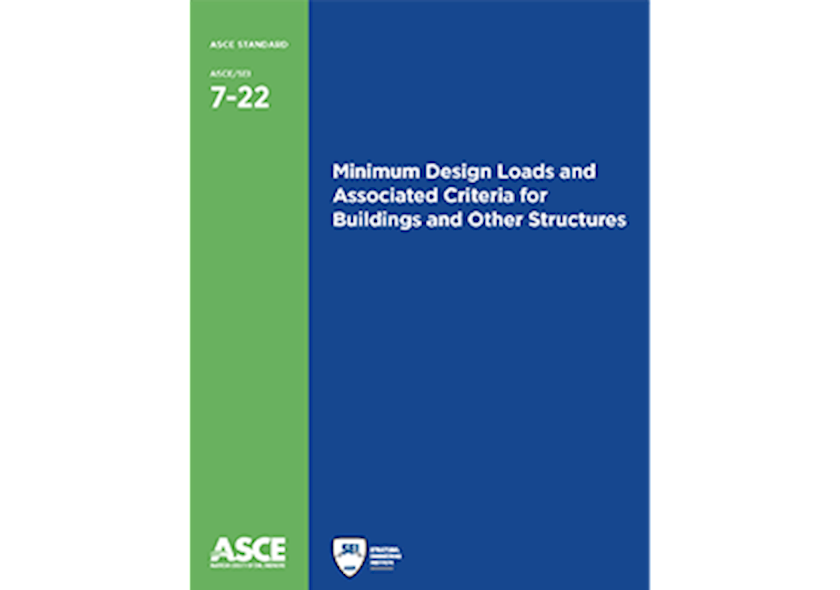Ensuring Load Safety for All Infrastructure: ASCE 7-22

Minimum Design Loads and Associated Criteria for Buildings and Other Structures, ASCE/SEI 7-22
ASCE 7 is the nationally adopted loading standard for general structural design. This standard prescribes design loads for all hazards including dead, live, soil, flood, tsunami, snow, rain, atmospheric ice, seismic, wind, and fire, as well as how to evaluate load combinations.
In addition to design loads, the standard also provides:
- Target reliability tables for tsunami and extraordinary loads. *
- Alternative method for loads from water in soil. *
- Provisions for emergency vehicle loads.*
- Updated tsunami data for Hawaii and many populous locations in California.
- Tsunami provisions for aboveground horizontal pipelines.*
- Revised ground snow loads to reflect more recent snow load data and reliability-targeted values.
-
Revised method for estimating drifts to include a wind parameter.
* new in ASCE 7-22
- Risk-targeted atmospheric ice load data for the continental United States and Alaska.*
- Lateral force resisting systems such as steel and concrete coupled composite plate shear walls, reinforced concrete ductile coupled shear walls, cross-laminated timber shear walls, and concrete tabletop structures.*
- Provisions for rigid wall, flexible diaphragm buildings (big box stores/warehouses).
- Provisions for supported and interconnected (coupled) nonbuilding structures.*
-
New chapter of tornado provisions.*
One of the most reliable ways to ensure increased performance and resilience of our nation’s built environment is the widespread adoption and enforcement of up-to-date, modern building codes and standards.
Who develops standards?
ASCE’s volunteer technical committees work collaboratively to develop standards that advance the civil engineering industry. The Structural Engineering Institute of ASCE and specifically the Minimum Design Loads and Associated Criteria for Buildings and Other Structures Standards Committee work on ASCE 7. Standards development is generally on a five-year cycle to revise or reaffirm existing standards. Voting members represent a cross-section of the industry including producers, consumers, and regulatory entities.
ASCE is an ANSI-accredited standards development organization (SDO). ASCE Standards provide technical requirements or guidelines for promoting safety, reliability, productivity, and efficiency in civil engineering.
What is covered by the Standards ASCE 7?
- Combination Loads
- Dead Loads
- Live Loads
- Seismic Design
- Ground Motions
- Flood Loads
- Wind Loads
- Rain Loads
- Tsunami Loads
- Snow and Ice Loads
How does ASCE 7-22 help communities?
ASCE 7 provides guidance on the basic requirements for the design and construction of buildings and other structures, ensuring adequate strength and stiffness to provide structural stability and structural integrity, as well as accounting for risks to human life, health and welfare resulting from structural damage or failure. Who is using it? ASCE 7 is an integral part of building codes in the United States and around the world and is adopted by reference into the International Building Code, International Existing Building Code, International Residential Code, and NFPA 5000 Building Construction and Safety Code. Structural engineers, architects, and those engaged in preparing and administering local building codes will find the structural load requirements essential to their practice.
Who is using it?
ASCE 7 is an integral part of building codes in the United States and around the world and is adopted by reference into the International Building Code, International Existing Building Code, International Residential Code, and NFPA 5000 Building Construction and Safety Code. Structural engineers, architects, and those engaged in preparing and administering local building codes will find the structural load requirements essential to their practice.
ASCE 7-22 is available in:
- Print (Soft Cover)
- E-book PDF
- Interactive digital access on the ASCE AMPLIFY platform

How do ASCE 7-22 and the ASCE Hazard Tool interact?
The ASCE Hazard Tool allows users to look up key design parameters specified in ASCE standards. This free resource connects users to precise hazard data for eight environmental hazards including seismic, wind, tornado, ice, rain, flood, snow, and tsunami. Users can generate and download free PDF design reports to use in engineering proposals. Specific ASCE Hazard Tool references are included in the ASCE 7 text (and on ASCE AMPLIFY, the digital engineering publications platform). Explore the ASCE Hazard Tool to learn more.

